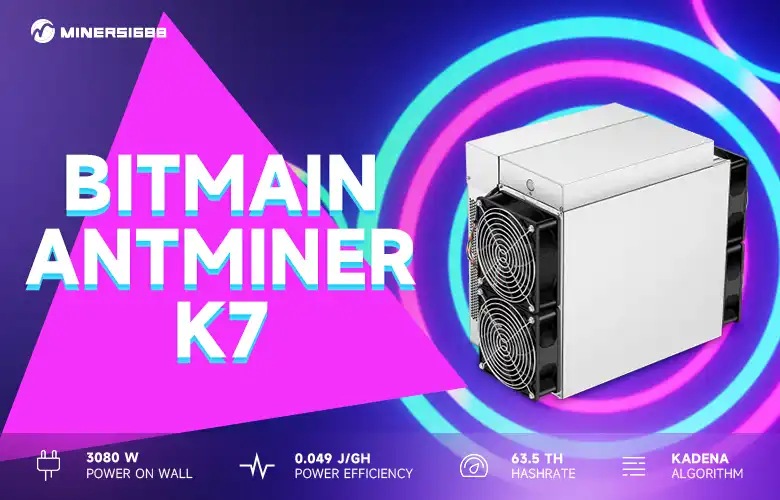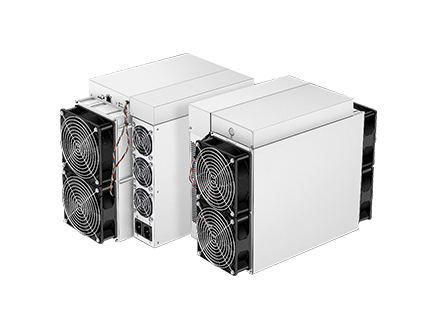Introduction
In the sprawling cosmos of cryptocurrency, Bitcoin takes the crown as the shining star, with mining its precious nuggets being a highly sought-after pursuit. This mining expedition, however, is no walk in the park. It calls for the decryption of intricate mathematical enigmas to validate transactions and safeguard the network. The gallant miners stepping up to this challenge are compensated with the gleaming allure of fresh Bitcoin, in addition to transaction fees.
Nonetheless, mining is not for the faint of heart, or for the ill-equipped. It necessitates highly specialized tools capable of executing computations with both speed and efficiency. Bitmain, a pioneering force in this field, has introduced a series of these high-powered tools, known as Antminers, over time.

Enter the Antminer K7. Bitmain’s newest brainchild, this powerhouse hit the market in January 2023 and swiftly claimed its spot as one of the most potent and profit-yielding mining contraptions currently available. It boasts a hash rate—a measure of processing power—of a whopping 63.5 terahashes per second (TH/s), dwarfing its precursor, the Antminer K5, which stands at a comparatively meager 6.8 TH/s.
The Antminer K7 not only outpaces its ancestors but also manages to be leaner on power consumption. It draws 3080 watts (W), making it about 2.5 times more efficient than its rival, the Toddminer C1, which gobbles up 7500 W.
In the following narrative, we shall delve into the intricacies of the Antminer K7—its attributes, performance, and how it stacks up against other players in the mining arena. Furthermore, we’ll share insights from those at the coalface—the miners who employ the Antminer K7 in their daily quest for Bitcoin and other cryptocurrencies. This intimate knowledge could be your stepping stone to the profitable, exciting world of Bitcoin mining.
What Makes a Profitable Antminer
If your ambition is to mine Bitcoin, you’re going to need an ally in the form of a mighty, efficient device that can conquer complex mathematical quandaries and conjure bitcoins out of the ether. This is precisely where Antminers enter the stage. Born from the innovative mind of Bitmain, a front-runner in the Bitcoin mining industry, Antminers are specialized apparatuses purpose-built for this task.
However, in this family of Antminers, not all siblings are equal. Some stand taller, producing more generous yields than others. The reasons behind this variance lie in a confluence of elements that sway their performance and earnings. Let’s embark on a journey to comprehend these elements and their role in your mining victories.
The Key Factors That Influence Profitability
The road to profitability for an Antminer is guided by five main signposts:
- Hash rate:This is the velocity at which a mining machine can conquer mathematical problems and birth bitcoins. The more rapid the hash rate, the more bitcoins a miner can amass within a set time frame.
- Power consumption:The energy appetite of a mining machine while it’s operating. Less power-hungry machines can save miners a hefty amount on electricity bills.
- Electricity cost:The tariff of electricity at the miner’s location. The more economical the electricity, the more savings on utility bills for the miner.
- Mining difficulty:The toughness of the mathematical problems, which flexes every fortnight in response to the network’s total hash power. A steeper mining difficulty makes it tougher to solve problems and generate bitcoins.
- Bitcoin price:The fluctuating market value of a Bitcoin, ruled by supply and demand. The heftier the Bitcoin price, the more profit a miner can rake in by selling bitcoins.
These influences are not solitary entities. They are intertwined, dynamic, and perpetually in flux. Their interplay defines your mining success.
Take for example, an influx of miners into the network. This surge causes an elevation in hash power, which in turn boosts the mining difficulty, dwindling the bitcoins yielded per unit of hash rate. This demands more energy from miners to sustain their earnings, which balloons their electricity costs. But there’s a silver lining – when Bitcoin prices ascend, miners can garner more revenue by selling their bitcoins, enhancing their profits.
The Importance of Hash Rate and Energy Efficiency
Out of these elements, hash rate and energy efficiency emerge as the pivotal characters determining an Antminer’s profitability. Both are directly tethered to the hardware and software blueprint of an Antminer, indicating how swiftly and how efficiently an Antminer can mine bitcoins.
Hash rate, quantified in terahashes per second (TH/s), embodies how many trillions of hashes an Antminer can compute per second. Energy efficiency, on the other hand, measured in joules per terahash (J/TH), illustrates how much energy an Antminer devours per terahash.
The quicker the hash rate, the more bitcoins an Antminer can procure in a set period. The greater the energy efficiency, the lesser electricity an Antminer uses per hash rate unit. Therefore, an optimal Antminer is one boasting a high hash rate but maintaining a low energy efficiency. However, these two attributes have an inherent tension—boosting one often sacrifices the other.
Finding the ideal balance between hash rate and energy efficiency is crucial to amplify profitability, depending on factors such as electricity cost, mining difficulty, Bitcoin price, among others.
In essence, to turn a profit mining Bitcoin with an Antminer, keep a close watch on its hash rate and energy efficiency. These are the chief indicators of its performance and earning potential. Also, be mindful of the other profitability influencers, such as electricity cost, mining difficulty, and Bitcoin price.
Overview of Antminer Series
Introduction to Different Models of Antminers
If you have ever set foot in the realm of Bitcoin mining, you are probably well-acquainted with the name ‘Antminer’. These specialized gadgets, designed to unearth Bitcoin, the jewel of cryptocurrency, are masters at solving complex mathematical problems and bolstering the network’s security.
Antminers are the brainchild of Bitmain, a pioneer and titan in the Bitcoin mining industry. Bitmain has, over the years, presented an array of Antminer models to the world, each a unique blend of features and performance capabilities.
The family of Antminer models stretches from S1 to S19, with each model boasting of distinct versions like Pro, T, and Z. The stalwarts of this series are primarily engineered to mine Bitcoin using the SHA256 algorithm, the most prevalent and competitive algorithm in the crypto landscape.
The Antminer roster also flaunts other models such as the L3, D3, X3, E3, Z9, K5, and K7, each crafted for mining other cryptocurrencies like Litecoin, Dash, Monero, Ethereum, Zcash, and Nervos Network. Each model has been tailored to leverage algorithms best suited for their specific coins.
In the following sections, we will be offering a sneak peek into the primary specifications and features of each Antminer model, and evaluate their performance and profitability in the current market scenario.
Key Specifications and Features of Each Model
The table below juxtaposes the primary specifications and features of each Antminer model that are currently available or slated to hit the market soon. This data, sourced from Bitmain’s official website or press releases, as well as reliable third-party resources, might vary based on different production batches or firmware updates. So, buckle up and let’s get started on our tour of the Antminer series.
In-depth Review of Antminer K7
Overview of the Antminer K7, including its release date and key features
Bitmain, with its latest masterpiece, the Antminer K7, has demonstrated a profound understanding of the cryptographic dance that underpins the blockchain in 2023. Like a finely tuned orchestra conducting the overture of Eaglesong, the custom algorithm curated for the Nervos Network (CKB), the Antminer K7 is both the conductor and the orchestra in this blockchain symphony.
In the universe of hashing power, where bigger is indeed better, the K7 is an undisputed heavyweight. It stands tall, ten times mightier than its predecessor, the K5, churning out 63.5 terahashes per second (TH/s). The K7 is akin to a hummingbird, seemingly serene, but with wings beating furiously, efficiently, and relentlessly.
When it comes to power consumption, the K7 is the embodiment of ‘less is more.’ Consuming merely 3080 watts (W), it sips electricity like fine champagne compared to the guzzling Toddminer C1, which draws a hefty 7500 W from the grid.
Efficiency is the mantra of the K7. It shames the Blackminer F1+ by offering an impressive four times better efficiency ratio of 48.5 joules per terahash (J/TH). The F1+ appears a sluggard in comparison, managing only 200 J/TH.
Bitmain, in its relentless pursuit of simplifying complex machinery, has integrated a power supply unit within the K7. This ease of installation and operation is a testament to Bitmain’s user-friendly approach to complex tech. And although the K7 might be a power-packed performer, it sings a soft symphony of 75 decibels, in harmony with the rest of the Antminer series.
The K7, with its compact 370 x 195 x 290 millimeters, weighs a comfortable 13.2 kilograms, effortlessly fitting into any mining setup. Listed on Bitmain’s official website for $6,999, the Antminer K7 is an investment, the returns of which will reverberate in the blockchain symphony. Note, though, that the final price may swing to the tune of the market, influenced by specific batches or resellers.
In its confidence in the Antminer K7, Bitmain offers a 365-day warranty for every new purchase directly from the manufacturer, standing behind the K7’s promising performance.
Discussion on its hash rate performance
The Antminer K7 soars through the crypto sphere with its potent hash rate, a feat achievable due to the marriage of exceptional hardware and software in its design. On the hardware front, the heart of the K7 is its BM1399E chip. This remarkable piece of silicon, customized and crafted with the precision of 7-nanometer FinFET technology, exhibits superior integration density and conservative power consumption. The result? The K7 performs a higher number of calculations per unit of energy, maximizing efficiency.
Within the software realm, the K7 dances to the rhythm of the Braiins OS+ firmware, specially optimized for the Eaglesong algorithm. This optimized firmware ensures smooth and stable running, with an intelligent capacity to auto-adjust frequency and voltage based on the prevailing mining conditions.
Pitting the K7 against other miners is a revealing exercise. Take, for instance, Bitmain’s flagship model for Bitcoin mining, the Antminer S19 Pro. Although it flaunts a slightly superior hash rate of 110 TH/s under the SHA256 algorithm (roughly 1.7 times that of the K7), it consumes approximately the same amount of power as the K7. Therefore, in the realm of efficiency, the K7 holds its own commendably.

Mining the Promise of the Nervos Network
The K7’s impressive hash rate shines even brighter when applied to mining the Nervos Network (CKB), an emerging and promising cryptocurrency. Nervos Network’s ambitious goal is to build a universal blockchain infrastructure that supports multiple layers and protocols. Its native token, CKB, forms the backbone of value and state storage within the network.
The Nervos Network operates on the Eaglesong algorithm, which can be characterized as both ASIC-friendly and a consumer of substantial memory. This is a landscape in which the Antminer K7 thrives, leveraging its specialized capabilities. For the more generalist GPUs or CPUs, it creates a formidable hurdle to entry. Thus, the K7 retains a clear advantage, occupying the competitive high ground.
The Nervos Network is a dark horse in the crypto race, bolstered by a buoyant demand and the blissful absence of overcrowded competition. As of the autumn month of October 2023, the coin index CoinMarketCap places CKB among the top 100 cryptocurrencies in terms of market capitalization, pegging its worth at approximately $0.01 per coin. Yet, only around ten mining pools exist that offer CKB mining support, cumulatively boasting a network hash rate of roughly 10 petahashes per second (PH/s). These circumstances, unusual for a coin of this standing, provide a golden opportunity for the K7: join one of these exclusive clubs, and the lion’s share of the CKB bounty could be theirs.
Potential is an overused word in the world of crypto, but for the Nervos Network, it seems apt. With its focus on scalability, interoperability, security, and sustainability, it’s architecting a future that addresses the existing shortcomings of other blockchains. The Nervos Network isn’t just another platform; it’s a visionary beacon in the blockchain space. By opting to mine CKB with the Antminer K7, miners do more than merely fuel the innovation engine of the platform. They sign up for a stake in a potentially prosperous future.
Discussion on Antminer K7’s Hash Rate Performance and Power Efficiency
The Antminer K7, equipped with the Eaglesong algorithm, is a force to be reckoned with in the Nervos Network (CKB) mining landscape. With an impressive hash rate and commendable power efficiency, it stands apart, outperforming others in the league.
How Antminer K7 Achieves Such a High Hash Rate Performance
What catapults the K7 to its high hash rate? Its secret lies in a harmonious blend of advanced hardware and tailored software. The heart of the K7 is a custom chip – the BM1399E, a testament to the power of 7-nanometer FinFET technology. High on integration density and low on power consumption, it crunches numbers like a dream.
The K7 also sports a specially optimized firmware, Braiins OS+, fine-tuned for the Eaglesong algorithm. It ensures smooth, stable operation, adjusting frequency and voltage in sync with the mining conditions.
When matched against its kin, the K7 holds its own. Take the Antminer S19 Pro, Bitmain’s flagship Bitcoin miner using the SHA256 algorithm. With a hash rate of 110 TH/s, it surpasses the K7’s 63.5 TH/s but does so at a similar power consumption, making the K7’s efficiency shine.
Positioned for Profit: K7 in the Nervos Network
The K7 enjoys a unique advantage in mining CKB, a newcomer in the crypto world with an ambitious vision of a universal blockchain infrastructure. The Eaglesong algorithm it operates on favors specialized devices like the K7 and sets a high memory demand. It’s a battlefield where the K7 triumphs, making it a tough act to follow for other miners.
CKB’s strong market demand and limited competition, coupled with its top 100 cryptocurrency ranking (as per CoinMarketCap), offers a ripe opportunity. Antminer K7 can take a considerable bite out of the CKB rewards by aligning with one of the limited mining pools. Plus, the K7’s role in mining CKB fosters the Nervos Network, aligning miners with its future growth trajectory.
How Antminer K7 Achieves Such a Low Power Consumption
How does the K7 keep its power consumption in check? An innovative cooling system and power supply unit are key. Its dual fans manage airflow effectively, minimizing heat build-up, while the advanced power supply unit streamlines power transfer, boosting energy efficiency.
When stacked against others like the Toddminer C1, another CKB miner using Eaglesong, the K7’s power efficiency is striking. It pulls off a hash rate about 5 times higher at less than half the power consumption, leading to considerable savings, particularly in regions where power costs are high.
Beyond cost savings, the K7’s power efficiency plays a crucial role in sustainable mining. It lowers the carbon footprint, making a positive impact on the environment. By choosing the K7, miners aren’t just opting for a high-performing machine; they’re supporting the planet.
Profitability of Antminer K7
Unleashing a high hash rate with an unexpectedly low power appetite, the Antminer K7 stands out among the crowd in mining Nervos Network’s (CKB) cryptocurrency. This efficiency equation promises profitability, but the question remains: how does it stack up against the competition?
Charting the K7 Earnings Landscape
Estimating K7 earnings involves a dance with a few variables – electricity rate, mining difficulty, and Bitcoin price. A profitability calculator is your map in this landscape, offering snapshots of potential daily, weekly, monthly, and yearly income.
Let’s look at a minerstat snapshot from August 1st, 2023. With a $0.10 per kWh electricity rate, a 1.91 T mining difficulty, and a Bitcoin price of $28,912.28, K7 miners could be looking at a daily income of $10.97, translating into a yearly income of $4,007.10. But remember, this landscape is ever-evolving.
In a different scenario, where the electricity rate rises to $0.15 per kWh, daily earnings slide down to $8.22, pulling the yearly income to $3,000.54. Conversely, with the Bitcoin price rocketing to $40,000, daily income could shoot up to $15.19, pushing the yearly income to $5,549.67.
The lesson? With profitability calculators, don’t forget to account for shifting sands. And always, do your due diligence before investing.
The K7 in the Mining Machine Arena
To understand K7’s profitability, we have to compare it against other contenders. A comparison tool like NiceHash provides such insights.
Consider Toddminer C1, another Eaglesong miner for CKB. Under similar conditions, Antminer K7 can generate a daily income of $11.37, dwarfing Toddminer C1’s $2.77.
However, against Bitmain’s flagship, Antminer S19 Pro, a Bitcoin miner under the SHA256 algorithm, K7 seems to lag. Despite similar operating conditions, Antminer S19 Pro secures a daily income of $25.74, overshadowing K7’s $11.37.
The final call? It comes down to assessing variables like hash rate, power consumption, the algorithm, the cryptocurrency, and your personal preferences. So, when considering the K7, remember to look beyond just the numbers. The right mining machine is the one that resonates with your situation and aspirations.
Mining Journeys with Antminer K7
Nestled in the universe of crypto mining machines, the Antminer K7 stands as a titan. With its potent hash rate of 63.5 TH/s and frugal power appetite of 3080 W, it stakes its claim as a compelling choice for mining the Nervos Network (CKB) cryptocurrency. Let’s delve into the candid tales of miners who’ve embraced the K7’s journey.
Navigating Miner Chronicles
The world of miners brims with authentic experiences that illuminate the Antminer K7’s potential. VoskCoin, a cryptocurrency YouTube hotbed, enthused about the K7’s ability to churn out $19 per day mining CKB, and crowned it as one of the top ASIC miners in 2023.
Dj Mines, another YouTube miner, sang similar praises, claiming a daily bounty of $30, and touted the virtues of EndlessMining, a rental service for ASIC miners.
The blog, Crypto Miner Tips, echoes these sentiments, hailing K7’s performance, durability, and its ability to bring in $30 a day.
These are more than testimonials – they’re practical guides and reviews wrapped in the miners’ experiences.
Mastering the K7
Mining is as much about maintenance as it’s about numbers. Keep your K7 in a cool, dust-free space with stable power. Regular cleaning with compressed air or a soft brush can keep your miner in top form.
Keep a pulse on your K7’s status using Bitmain’s interface or API monitoring software, and adapt the frequency and voltage settings according to your preferences and mining conditions.
Join a reputable mining pool that aligns with your objectives, offering low fees, high rewards, and stability. Don’t forget to gauge your earnings via a profitability calculator, taking into account variables like electricity rates and mining difficulty.
Where to Seek More K7 Wisdom?
Bitmain offers 24/7 support and maintains community forums for users to exchange ideas. Staying tuned to Bitmain’s social media channels can also provide valuable insights.
Ultimately, the key to a fruitful journey with the Antminer K7 lies not just in the raw numbers, but in joining the miner community, understanding the machinery, and continuously adapting to the crypto terrain.
Conclusion
In this exploration, we’ve journeyed through the landscape of Antminer K7, a mining giant that drinks from the Eaglesong algorithm and uncovers the Nervos Network (CKB) cryptocurrency. We’ve meandered through its performance and profitability, the real-world accounts of miners, and handy hints to get the most out of your K7. Now, it’s time to rewind and ponder on what the future holds.
Recap of the Antminer K7’s Features and Performance
The K7 stands tall with its robust hash rate of 63.5 TH/s and a frugal power diet of 3080 W. It boasts a custom chip, the BM1399E, developed with the 7-nanometer FinFET technology and it’s backed by Braiins OS+ firmware, optimized for Eaglesong.
With the potential to reel in up to $30 per day mining CKB, the K7 isn’t just profitable. It’s a low-risk pathway to mine in a market with high demand and tepid competition, promising long-term prospects with the growth of Nervos Network, a rising star in the blockchain universe.
Future Prospects for Antminer Machines and the Bitcoin Mining Landscape
The crypto cosmos is ever-evolving, and here are a few predictions:
Bitmain, the architect of Antminer, is likely to unroll new models with superior performance, lower power needs, and better energy efficiency. Antminer K8 or K9, anyone?
Bitmain may also support new algorithms, creating new mining opportunities with varied profitability levels. This could shake up the ASIC and GPU mining supremacy in Ethereum or Monero.
With competitors like Innosilicon, MicroBT, Canaan, and Ebang, Bitmain will need to stay on its toes. And, Bitcoin miners will navigate regulatory and innovation shifts that may affect operations and profitability.



